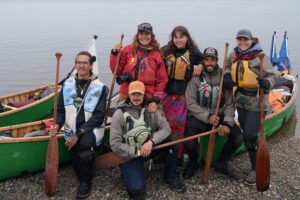Sea kayaker Cyril Derreumaux has started paddling across the Atlantic Ocean. He pushed off from La Restinga in the Canary Islands this morning and will travel 4,800km alone to Martinique.
Derreumaux, 46, had planned to leave on December 17, but a gale pushed that back twice. He finally left today.
While rowing the oceans has become popular, thanks to annual races across the Atlantic and Pacific, only a handful of people have successfully kayaked the Atlantic. Derreumaux wants to add his name to that very short list.
He hopes to finish in 75 days but estimates that the crossing will take between 70 and 90 days, depending on what the ocean throws at him.

The route. Image: Cyril Derreumaux
Pacific prelude
Two years ago, he kayaked across the Pacific from California to Hawaii. What he thought would be a 70-day journey took 91 days. This 2022 Pacific paddle, Derreumaux’s first big journey, was inspired by Ed Gillet’s legendary 1987 crossing. The route Derreumaux took was identical, but the experience was quite different. Gillet used an off-the-shelf Tofino double kayak, an SOS transmitter, and a radio, while Derreumaux had a self-righting, state-of-the-art vessel that was built with an ocean crossing in mind.
Derreumaux doesn’t think anyone will ever recreate Gillet’s journey. He describes Gillet as a trailblazer and a maverick. Speaking to ExplorersWeb after his first ocean crossing, he said, “He inspired me, and I’ve been in touch with him many times. The way he did it, sleeping in the cockpit with a tarp over himself, navigating with a sextant and no communication whatsoever, he was truly solo. I was solo because I was alone in the boat, but I had land support. I could text back and forth and even make a phone call when I had issues. He’ll never be reproduced.”

Valentine, Derreumaux’s craft. Photo: Cyril Derreumaux
Custom-built kayak
The French-born explorer will once again complete his journey in Valentine, the seven-meter vessel that carried him across the Pacific. Fully loaded, it weighs 370 kilograms. It does not resemble a traditional kayak. It has an enclosed cabin for sleeping, solar panels, an external antenna for making phone calls to his land team, and a pedal system. This means that besides paddling, Derreumaux can pedal to propel himself forward. This will allow him to use different muscle groups on the lengthy crossing.
He expects the first two weeks to be the most challenging. He will have to contend with seasickness, sleep deprivation, and adjusting to paddling for such extended periods.
Derreumaux plans to follow the routine that worked for him on the Pacific. Starting at sunrise, he will paddle for five hours, then stop to eat, and do another five-hour stint. He will try to get a few more hours in if conditions are good. Throughout the night, he will wake up every two hours to check on the boat and its position.
You can follow his progress here.






